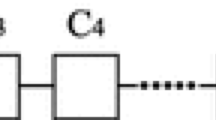Abstract
In a previous work (see [3]) we presented a general scheme to solve the 1D Generalized Firing Squad Synchronization Problem. We designed it in a modular way using the concept of fields (open CA). The solution was not designed as a finite cellular automaton because we needed unbounded integers as states for distance fields, and the recursive nature of the algorithm leaded to a unbounded number of fields. In this paper, we show as claimed, that this approach does lead to a finite cellular automaton. We exhibit a transformation function from infinite to finite states and write a program that generates the associated finite transition table while checking its validity and the conservation of the input-output behavior of the original cellular automaton.
Access this chapter
Tax calculation will be finalised at checkout
Purchases are for personal use only
Preview
Unable to display preview. Download preview PDF.
Similar content being viewed by others
References
Balzer, R.: An 8-state minimal time solution to the firing squad synchronization problem. Information and Control 10, 22–42 (1967)
Maignan, L., Gruau, F.: Integer gradient for cellular automata: Principle and examples. In: Self-Adaptive and Self-Organizing Systems Workshops, SASOW 2008, pp. 321–325 (2008)
Maignan, L., Yunès, J.-B.: A spatio-temporal algorithmic point of view on firing squad synchronisation problem. In: Sirakoulis, G.C., Bandini, S. (eds.) ACRI 2012. LNCS, vol. 7495, pp. 101–110. Springer, Heidelberg (2012)
Maignan, L., Yunès, J.B.: Moore and von Neumann neighborhood n-dimensional generalized firing squad solutions using fields. In: AFCA 2013 Workshop. CANDAR 2013 Conference, Matsuyama, Japan, December 4-6 (2013)
Mazoyer, J.: A six-state minimal time solution to the firing squad synchronization problem. Theoretical Computer Science 50, 183–238 (1987)
Moore, E.E.: Sequential Machines, Selected Papers, pp. 213–214. Addison-Wesley (1964)
Noguchi, K.: Simple 8-state minimal time solution to the firing squad synchronization problem. Theoretical Computer Science 314(3), 303–334 (2004)
Schmidt, H., Worsch, T.: The firing squad synchronization problem with many generals for one-dimensional CA. In: Levy, J.-J., Mayr, E.W., Mitchell, J.C. (eds.) 3rd IFIP International Conference on Theoretical Computer Science. IFIP, vol. 155, pp. 111–124. Springer, Boston (2004)
Yunès, J.B.: An intrinsically non minimal-time Minsky-like 6-states solution to the firing squad synchronization problem. RAIRO-Theor. Inf. Appl. 42, 55–68 (2008)
Author information
Authors and Affiliations
Editor information
Editors and Affiliations
Rights and permissions
Copyright information
© 2014 Springer International Publishing Switzerland
About this paper
Cite this paper
Maignan, L., Yunès, JB. (2014). Experimental Finitization of Infinite Field-Based Generalized FSSP Solution. In: Wąs, J., Sirakoulis, G.C., Bandini, S. (eds) Cellular Automata. ACRI 2014. Lecture Notes in Computer Science, vol 8751. Springer, Cham. https://doi.org/10.1007/978-3-319-11520-7_15
Download citation
DOI: https://doi.org/10.1007/978-3-319-11520-7_15
Publisher Name: Springer, Cham
Print ISBN: 978-3-319-11519-1
Online ISBN: 978-3-319-11520-7
eBook Packages: Computer ScienceComputer Science (R0)




